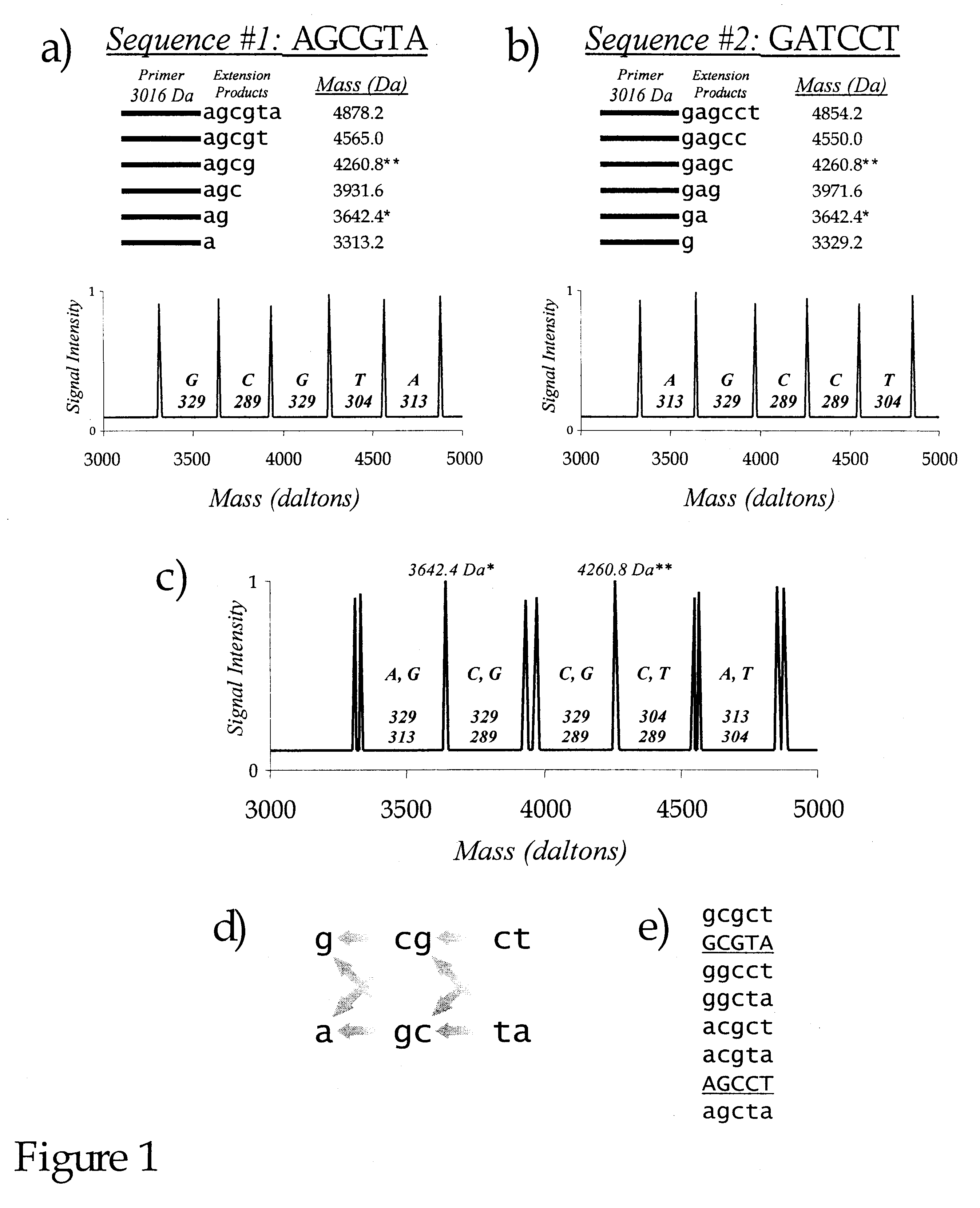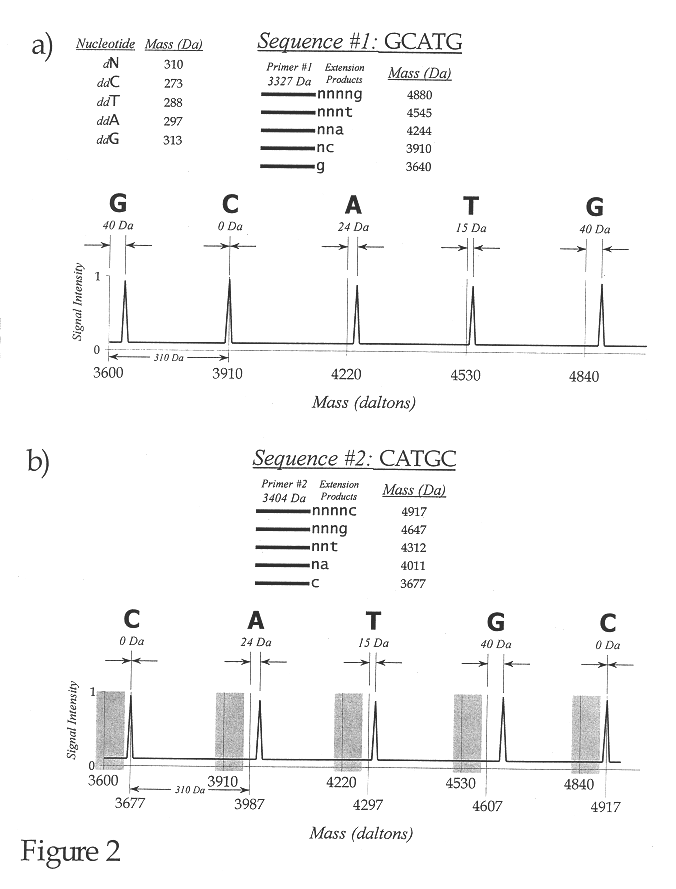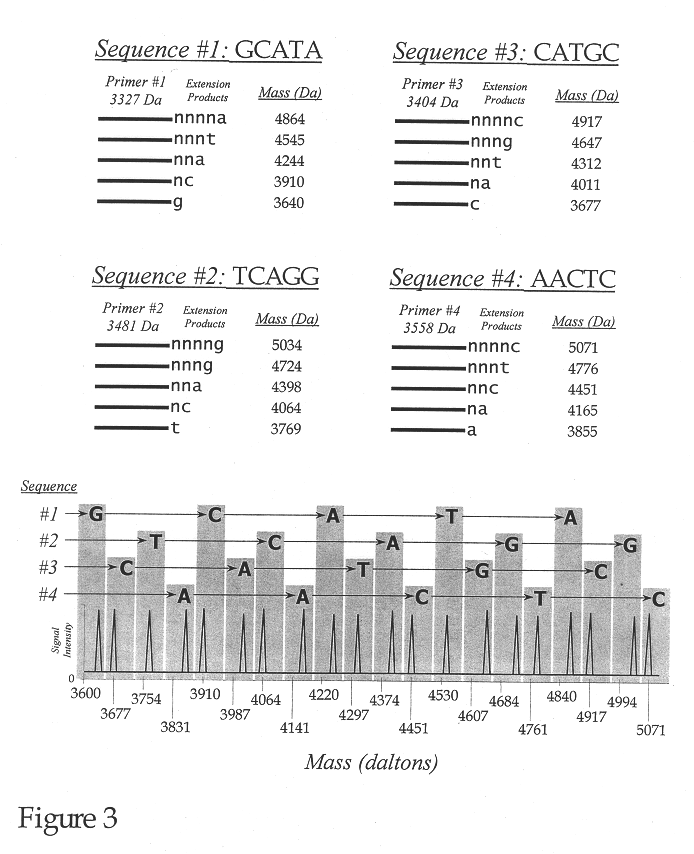Use of nucleotide analogs in the analysis of oligonucleotide mixtures and in highly multiplexed nucleic acid sequencing
a technology of oligonucleotide mixture and nucleic acid sequencing, which is applied in the direction of material analysis using wave/particle radiation, process and machine control, synthetic resin layered products, etc., can solve the problems of tedious repetitive sequencing reactions, cumbersome procedures, and limited sequencing
- Summary
- Abstract
- Description
- Claims
- Application Information
AI Technical Summary
Benefits of technology
Problems solved by technology
Method used
Image
Examples
example 2
Forced Mass Modulation using Pair-Matched Deoxynucleotides
Implementation of Forced Mass Modulation using pair-matched nucleotides is shown in FIG. 4a-d. The basic requirement for this method is that the sequencing reaction products can be analyzed as double-stranded structures. Briefly, the steps in the reaction are as follows: 1) A partially duplex hairpin primer with a 3' overhang and a 5' phosphate group is annealed and ligated to the single stranded target sequence. 2) The resulting partially duplex structure is subjected to a sequencing reaction using the pair-matched nucleotide set described above along with the set of mass-matched terminators (ddM). 3) The products from the sequencing reaction are exposed to a strict single strand-specific nuclease that results in the production of blunt-ended hairpin structures ready for analysis by mass spectrometry. FIG. 5a-b shows the products and molecular masses of the nuclease digestion along with a simulated mass spectrum.
Because the ...
example 3
Forced Mass Modulation in the Detection and Scoring of Single Nucleotide Polymorphisms
Forced Mass Modulation can be used to simplify the analysis of closely related sequence variants, as is required in the detection and scoring of single nucleotide polymorphisms. FIG. 6a-d shows three sequence variants that differ from each other only at a single base position sequenced by a conventional Sanger reaction. The mass distribution of the reaction products is so complex that it can be uninterpretable, even if the base sequences of the variants are known a priori.
FIG. 7a-d shows the same three variants sequenced by Forced Mass Modulation using mass-matched deoxynucleotides (dN=310 Da) and the standard dideoxy terminators. The positions and identities of the single-nucleotide changes are immediately apparent from the mass spectrum. Since the masses of the sequencing reaction products are constrained to fall within the shaded regions of the spectrum in FIG. 7b, it is possible to multiplex ot...
example 4
Base Composition Density Distributions for the Total Set of Possible 7-Base Oligonucleotides
For this implementation, three sets of 7-base oligonucleotides comprising all possible base compositions for a 7-base oligonucleotide can be obtained; the first set comprising the four natural bases (dA, dG, dO and dT), the second set comprising three of the natural bases (dA, dC and dT) and the nucleotide analog 7-deaza-deoxyguanosine (7-deaza-dG) substituted for dG, and the third set comprising three of the natural bases (dA, dG and dC) and the nucleotide analog deutero-deoxythymine (deutero-dT) substituted for dT. FIG. 8i-iii shows the actual base composition density distributions for the total set of possible 7-base oligonucleotides using the three different nucleotide sets. Note that for the set of naturally occurring bases (FIG. 8i), nearly every base composition has its own distinct mass value, but most of these mass values are spaced only one dalton from each other. Increasing the pea...
PUM
| Property | Measurement | Unit |
|---|---|---|
| mass | aaaaa | aaaaa |
| molecular weights | aaaaa | aaaaa |
| molecular weight | aaaaa | aaaaa |
Abstract
Description
Claims
Application Information
 Login to View More
Login to View More - R&D
- Intellectual Property
- Life Sciences
- Materials
- Tech Scout
- Unparalleled Data Quality
- Higher Quality Content
- 60% Fewer Hallucinations
Browse by: Latest US Patents, China's latest patents, Technical Efficacy Thesaurus, Application Domain, Technology Topic, Popular Technical Reports.
© 2025 PatSnap. All rights reserved.Legal|Privacy policy|Modern Slavery Act Transparency Statement|Sitemap|About US| Contact US: help@patsnap.com



